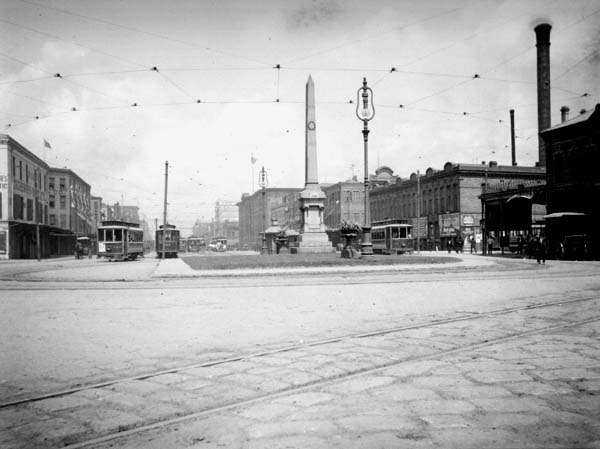J.P. Macheca, later linked with local Mafia,
played key role in Reconstruction Era battle
 |
| Frank Leslie's Illustrated Newspaper |
On this date in 1874, New Orleans merchant Joseph P. Macheca played a critical role in the White League's defeat of a militia/police force controlled by Louisiana's Reconstruction-Era Republican state government. The conflict stemmed from contested elections that resulted in the creation of competing state administrations and legislatures and from the Republican government's creation of a Metropolitan Police force that included many black officers. The conservative Democratic administration formed its own militia, calling it "Louisiana's Own," and prepared for conflict.
 |
| Macheca |
Following failed negotiations on September 14, 1874, Republican forces led by former Confederate General James Longstreet and Metropolitan Police "General" Algernon Badger moved several thousand men into position on the downtown side of Canal Street, at the edge of the French Quarter. Badger personally commanded hundreds of Metropolitan Police, along with 12-pound cannons and Gatling guns, in a location between the U.S. Customs House and the levee. The police force was made up largely of recent African-American recruits, lacking experience and training. Longstreet oversaw militia units further from the levee.
White League paramilitary forces, including many Civil War veterans, were already assembled behind barricades along Poydras Street, a few blocks uptown from Canal. They hoped to lure Republican forces into an uptown trap. Shouted taunts, snipers and a quick attack and retreat failed to entice Longstreet into an advance.
Captain Joseph P. Macheca's Company B of Second Regiment "Louisiana's Own" made the decisive move. Initially hiding behind piles of unloaded freight on the levee, the unit used an approaching train to cover its movement toward Badger's left flank. Macheca's three hundred men (the roster of his Company B at Jackson Barracks Military Museum lists only 120) consisted largely of Italian and other European immigrants drawn from the French Quarter.
 |
New Orleans Bulletin
Sept. 18, 1874 |
As the train passed, Company B swarmed in from the levee. Badger's inexperienced police were taken completely off-guard. Most fled into the French Quarter. Badger was injured when his horse was shot from under him. He was protected from further injury by Macheca and his men. (Some wished to hang the police commander.)
Following the collapse of Badger's position, other Republican units melted away downtown into the French Quarter. The White League militia did not immediately pursue, and its victory was not complete until the following morning, September 15. It was then that White League Colonel John G. Angell began to probe across Canal Street and found no Republican resistance. Several blocks into the French Quarter, Angell discovered Macheca's men in control of key Republican positions, including the Republican arsenal. Macheca turned over to Angell thousands of seized weapons, two artillery pieces and hundreds of prisoners.
Democratic forces retained control in the city only for a short time, as U.S. President Grant moved the federal military into the area to support the return of the Republican government. White League supporters, viewing the conflict in New Orleans as a battle against oppression, later named the fight, "the Battle of Liberty Place" and referred to it as the final battle of the Civil War. (A monument to the battle was installed on Canal Street in 1891. The monument, which became a symbol for the white supremacist movement, was removed during 1989 construction on Canal Street and later erected on Iberville Street.
It was dismantled on April 24, 2017.)
Apparently uncomfortable with its debt to the Italian-American force commanded by the Louisiana-born, ethnically Italian Macheca, the White League sought to minimize Macheca's role in histories of the event. (The White League record, published in the
New Orleans Daily Picayune and
New Orleans Bulletin on Oct. 2, noted that Colonel Angell was ordered to advance from Canal Street on the fifteenth. The report stated vaguely, "By 10 o'clock A.M., Col. Angell was in the possession of all the enemy's important points below Canal street, having received material assistance in this movement from Capt. Macheca.") However, accounts have survived showing that Macheca was first to arrive at the side of fallen General Badger and that he turned over captured Republican strongholds in the French Quarter to Colonel Angell. In addition, when Macheca felt slighted by local press coverage, he sent his own account to the
New Orleans Bulletin (see image).
 |
| Map of the battle. |
A number of Macheca's men later became key figures in the New Orleans Sicilian business community and the Sicilian underworld. Sixteen years after the Battle of Liberty Place, Macheca and members of the New Orleans Mafia were arrested in connection with the assassination of New Orleans Police Chief David Hennessy. Macheca was one of eleven men killed after an angry mob stormed Orleans Parish Prison early in 1891.
Read more about "Liberty Place," Joseph Macheca and the early New Orleans Mafia in:








